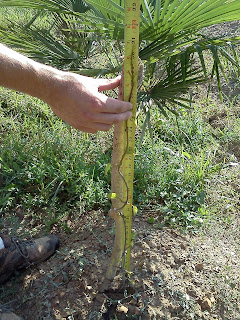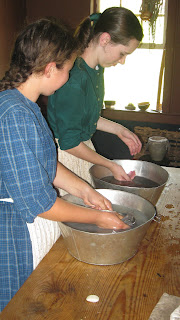It's time to take a break from yams and return to Settlement! While yams have been growing, we have been working hard across the museum on the American side to finish building up our chimney before the cold weather hits. Yes, I am aware that the high today reached 92 degrees in Staunton. But we're a month and a day away from October, and that means cold weather! So for this post, we will take you through the steps necessary to build a basic rough chimney for a temporary home in the 1730s/40s Virginia backcountry. The Augusta County Militia guys began this hard job last year, and now our staff is finishing it.
The bottom of chimney is stacked stone. It stops about chest high, because if we continued higher, it would become too dangerous. We aren't stone masons. Neither were they. We would need a stone mason to build it all out of stone, and for a quick shelter that we'd make in a couple months and live in for only a few years, it would be impractical to have a nice stone chimney. In fact, we're lucky we even got to build the bottom chunk of stone! On the other side of the colony, the entire chimney might be stick-and-daub, because there isn't enough rock over there! So the rest of the chimney is made out of wood.
Using the right kind of wood is important. Because the upper portion of the chimney is stacked wood covered in mud daubing, it is likely that as the daub dries and cracks to expose the log, it will catch fire some day. If you pick pine to build your chimney, that stuff will catch a spark and go up in flame before you know it. It's best to pick a harder wood that burns slower, such as oak. It'll give you more time to go outside and pull the chimney down, so the rest of your house doesn't catch.
Once we had our oak tree trunks, we split them all down into quarters, sometimes eighths, about the same size for fence rails. We'll talk more about splitting rails in the future. Here is Andy, determining where to place the next metal wedge, while a wooden glut holds the log open.
Once they are split to size, they need to be cut down to length. We needed our chimney to taper from a wide bottom to a smaller top, so we had to measure out the exact length we wanted our pieces.
Some of the rails were cut down to length using an ax last year, and these recent ones we did with a period hand saw. See the difference in the look below (note: these pieces have been fully worked into square shapes at this point).
Our rails initially are all shaped like a slice of pie- triangular. In order to get that nice squared-off shape that you see above, pull out a fro, a fro club, and a hatchet. The fro is an L-shaped tool, with the sharp blade on the bottom. The fro club is a big wooden mallet we use to drive the fro into the top of the wood, to pry the wood apart. We also use the fro to make the roof shingles, and all our fence palings. Below, I place the fro to cut off the triangular tip of our piece.
Here's the fro club. The pieces are short enough that the fro work is easy. Drive it in, pull the handle, and POP! But, if the wood gives you lots of "stringies" and becomes difficult to pry apart, like this one did, you can use the handle of the fro club to keep the piece open as you slide the fro down to pry lower. Once the tip is off, the piece is still trapezoidal, so pull out the hatchet and start [carefully] hacking down the wider edge to match the thinner edge.
Once the stacking begins, we need two people. Just because we squared it off earlier doesn't mean it'll sit nice and flat on the piece below! Andy leads the effort by climbing the chimney, and I hand him up each piece, hoping it works on the first try. It occasionally does, but most pieces he hands back down to me, with instructions such as, "Take about a quarter inch from this spot here down to the bottom." I shave the piece down, and hand it back up. Sometimes, it takes a couple tries to get the piece to sit stable on top the chimney.
We keep doing this until it finally reaches the desired height. It needs to be a little taller than the house, in order for it to draft properly when we build a fire inside. As we learned, it's difficult to judge how much wood you need to reach that height without actually stacking it. Also notice that there is a significant space between the the chimney and the north wall of the cabin. Remember how I said earlier that it might catch on fire at some point? If the chimney leans away from the wall, it'll be less likely to catch too. When you finish, be sure to take a fun and artsy photo or two! Notice all those little black square smudges on the pieces? Those are the shadows from our iron wedges from when we split the logs in the first step.
Now that our chimney is finally stacked, we will start daubing it with mud TOMORROW! If you're in the area, come on by tomorrow during museum hours (9-5). Visitors are invited to daub with us, but if jumping in mud isn't your thing, we'll take friendly words of encouragement!






























































